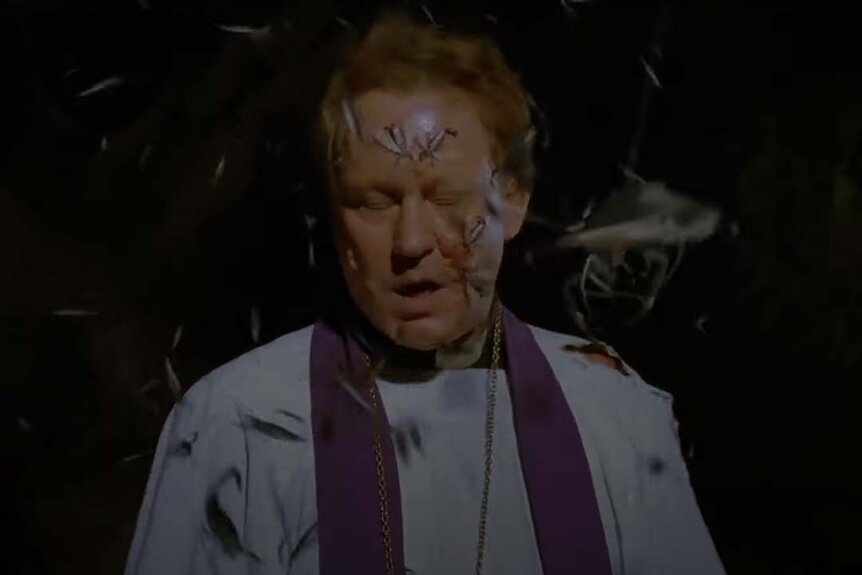Create a free profile to get unlimited access to exclusive videos, sweepstakes, and more!
Are Exorcisms Real? What to Know About "Real-life Possession"
That depends on your definition of exorcism and your definition of real.
The Exorcist is one of those most enduring horror stories ever told, with a new sequel, The Exorcist: Believer, hitting theaters this weekend. The original scare fest popularized a vision of demonic possession and exorcism which still influences the cultural consciousness today and redefined the way we imagine evil. Dominion: Prequel to the Exorcist (streaming now on Peacock!) offers an alternative origin story for the events leading up to The Exorcist when an archaeological dig releases a demon from a sealed underground temple.
Throughout history, people have told stories both fictional and allegedly real, about demons and devils inhabiting people’s bodies and controlling their minds or actions. And the Catholic Church itself has admitted that, yes, they sometimes do exorcisms. But does the reality of exorcism in the modern world have any resemblance to the stories we tell? Let’s find out.
The Inspiration for The Exorcist, and Every Other Modern Possession Story
The 1973 horror classic The Exorcist was written by William Peter Blatty and adapted from his own novel of the same name. According to Blatty, the story was inspired by a Washington Post article he read about the exorcism of a possessed Maryland boy. A portion of the original posting was republished more recently.
RELATED: Why Are There Two Different Exorcist Prequels?
In it, the author Bill Brinkley reports that a devoted Catholic priest remained with a 14-year-old boy for two months while fighting the devil inside him. Allegedly, the boy broke out in Latin, a language he didn’t speak, and the bed sometimes moved spontaneously across the room. They also reported fruit leaping from the fridge top and flying across the room. Later investigation revealed that the details of the exorcism had been sensationalized and were largely unconfirmed. We do know that there was an exorcism, but that’s about it. The fantastical details which dominate our image of exorcisms were likely exaggerated or entirely invented. The story, however, was a good one. And it stuck.
What we see in the movie does have a sort of superficial similarity to the Catholic Church’s official description of exorcism, but without quite so much tension, excitement, and projectile vomiting.
A Brief (and Incomplete) History of Exorcisms
We usually think of exorcisms performed by the Catholic Church, all robed clergy wielding crosses, scripture, and holy water in a physical and psychic battle for a person’s soul. That’s a relatively modern sentiment, because exorcisms are much older than the Catholic Church — there are several depictions of exorcisms in the Bible, which necessarily came from pre-Christian sources — and have been performed in various ways by various cultures for thousands of years.
The precise details of those prayers, rites, and rituals change from culture to culture and over time as our relationship with the concept of evil evolves. In fact, even if we focus only on the Christian interpretation of an exorcism, we see that it has changed dramatically over the centuries.
RELATED: Everything to Know About The Exorcist: Believer
In the 4th Century, exorcisms were incredibly common, quite literally an everyday occurrence. New converts to Christianity would be exorcised of evil forces every day leading up to their baptism. And just before baptism, the priest would blow on a convert’s face, an act known as exsufflation, in an effort to literally blow evil forces out of the body. At the time, exorcisms were also carried out through the laying on of hands. Today, we would more commonly call that a “blessing,” not an exorcism. But at the time, and even now, the line between prayers, blessings, and exorcisms is blurry.
In the 12th Century, the concept of exorcisms underwent a dramatic shift in response to schisms within Christianity. Then, even personal prayer was considered a form of exorcism, as it was an act intended to bring a person closer to god and further from evil.
It wasn’t until 1614 that the Vatican first released guidance on exorcisms. That guidance remained in place and unchanged for nearly four centuries before it was revised in 1999. The document, known as De Exorcismis et Supplicationibus Quibusdam (Of Exorcisms and Certain Supplications) refers to exorcism as a special kind of prayer, protecting a person against the devil or pulling them away from his dominion. The word “prayer” is doing a little bit of extra heavy lifting here, but not as much as you might think.
What Is an Exorcism, Really?
In the modern Catholic Church, there are two kinds of exorcisms, the first of which hearkens back to a more historical definition of exorcism. Even now, the rites for both adult and child baptism call for a person to receive one or more “minor exorcisms” before the actual baptism. The purpose of a minor exorcism is not to cast out demons but to help a person step away from the influence of the devil.
By contrast, a “major exorcism” is intended to expel the literal presence of the devil in a person’s literal body. These kinds of exorcisms can only be performed officially by a bishop or a priest who has received permission from the Church.
The first part of any exorcism proceeding, often skipped over in the movies, involves the engagement of earthly doctors and psychiatrists. Nearly agreeing with non-believers, the Catholic Church notes that the vast majority of suspected demonic possessions are caused and solved by more terrestrial forces. In most cases, a reported possession is treated by doctors, not by clergy.
RELATED: How Exactly Did Linda Blair Contribute To The Exorcist: Believer As Technical Advisor?
However, if Church officials determine that conventional medicine and treatment is insufficient, they may refer a person to an exorcist. If that happens, here’s what you can expect. First, they will begin by reading the Psalms, other scriptural excerpts, and reciting an exorcistic prayer. Water is blessed and sprinkled on the possessed, mirroring the baptism. A priest or bishop may place their hands on a person and even blow on their face, recalling the exsufflation of old. Lastly, the possessed is shown the Lord’s Cross and the Sign of the Cross is made over them, according to the United States Conference of Catholic Bishops.
The Catholic Church has made efforts to formalize the exorcism process with a focus on the protection of the “afflicted” in large part because exorcisms do have a tragic relationship with abuse and death. As recently as 2022, members of a family in California were arrested and charged with murder of a 3-year-old during an alleged exorcism.
Are exorcisms real? Sure! They’ve been around for millennia and have shifted over time to fit the prevailing image of evil. Today, they happen both inside and outside of official religious channels all over the world. Is there evil involved? Maybe, sometimes. It’s hard to see a story about a child killed by their family over an invisible threat and not see something evil there. But are they what they claim to be, a battle between good and evil, a physical fight for the immaterial soul on the material plane? That depends on who you ask.
The Exorcist: Believer hits theaters nationwide on Friday, October 6. Get tickets now at Fandango.
Catch Dominion: Prequel to the Exorcist and a bunch of other demonic faves streaming now on Peacock.

































